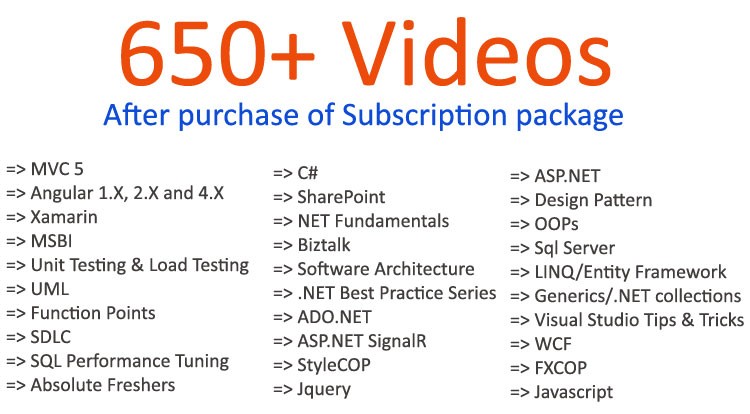UML Training: - Can you explain many types of diagrams in UML(Unified Modeling Language)?
- By Shiv Prasad Koirala in .Net
- May 18th, 2012
- 4782
- 0
There are nine types of diagrams in UML:-
Use case diagram:
They describe "WHAT" of a system rather than "HOW" the system does it. They are used to identify the primary elements and processes that form the system. The primary elements are termed as "actors" and the processes are called "use cases". Use Case diagrams shows "actors" and there "roles".
Class diagram:
From the use case diagram, we can now go to detail design of system, for which the primary step is class diagram. The best way to identify classes is to consider all "NOUNS" in use cases as classes, "VERBS" as methods of classes, relation between actors can then be used to define relation between classes. The relationship or association between the classes can be either an "is-a" or "has-a" relationship which can easily be identified from use cases.
Object diagram:
An object is an instance of a class. Object diagram captures the state of classes in the system and their relationships or associations at a specific point of time.
State diagram:
A state diagram, as the name suggests, represents the different states that objects in the system undergo during their life cycle. Object change in response to certain simulation so this simulation effect is captured in state diagram. Therefore, it has a initial state and final state and events that happen in between them. Whenever you think that some simulations are complicated, you can go for this diagram.
Sequence diagram:
Sequence diagrams can be used to explore the logic of a complex operation, function, or procedure. They are called sequence diagrams because sequential nature is shown via ordering of messages. First message starts at the top and the last message ends at bottom. The important aspect of a sequence diagram is that it is time-ordered. This means that the exact sequence of the interactions between the objects is represented step by step. Different objects in the sequence diagram interact with each other by passing "messages".
Collaboration diagram:
A collaboration diagram groups together the interactions between different objects to fulfill a common purpose.
Activity diagram:
Activity diagram is typically used for business process modeling, for modeling the logic captured by a single use case, or for visualizing the detailed logic of a business rule. Complicated process flows in the system are captured in the activity diagram. Similar to a state diagram, an activity diagram also consists of activities, actions, transitions, initial and final states, and guard conditions. However, difference is state diagrams are in context of simulation while activity gives detail view of business logic.
Deployment diagram:
Deployment diagrams show the hardware for your system, the software that is installed on that hardware, and the middleware used to connect the disparate machines to one another. It shows how the hardware and software work together to run a system. In one, line its shows the deployment view of the system.
Component diagram:
The component diagram represents the high-level parts that make up the system. From .NET angle point of view, they form the "NAMESPACES". This diagram depicts, at a high level, what components form part of the system, and how they are interrelated. Its shows the logical grouping of classes or group of other components.
See the following video on UML diagram: -
Click to get UML Training
Regards,
Get more UML training stuffs from author's blog
Shiv Prasad Koirala
Visit us @ www.questpond.com or call us at 022-66752917... read more

- By Shiv Prasad Koirala
- Jun 21st, 2013
- 164145
- 0
.NET interview questions 6th edition (Sixth edition) - By Shivprasad Koirala

- By Shiv Prasad Koirala
- Dec 8th, 2016
- 89248
- 0
Exception Handling in C# using example step by step

- By Shiv Prasad Koirala
- Sep 7th, 2013
- 72069
- 0




